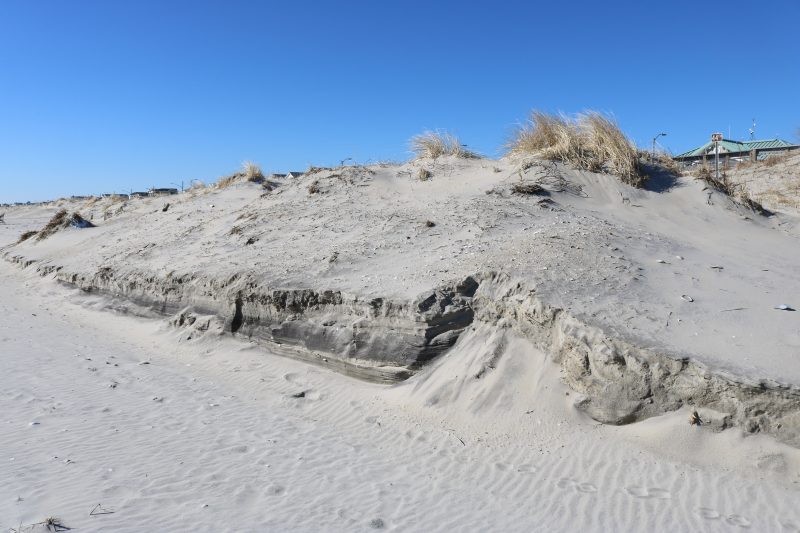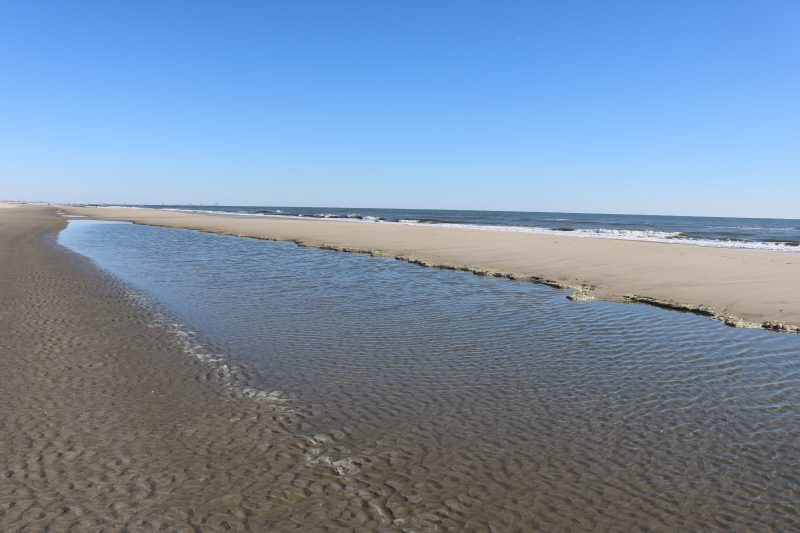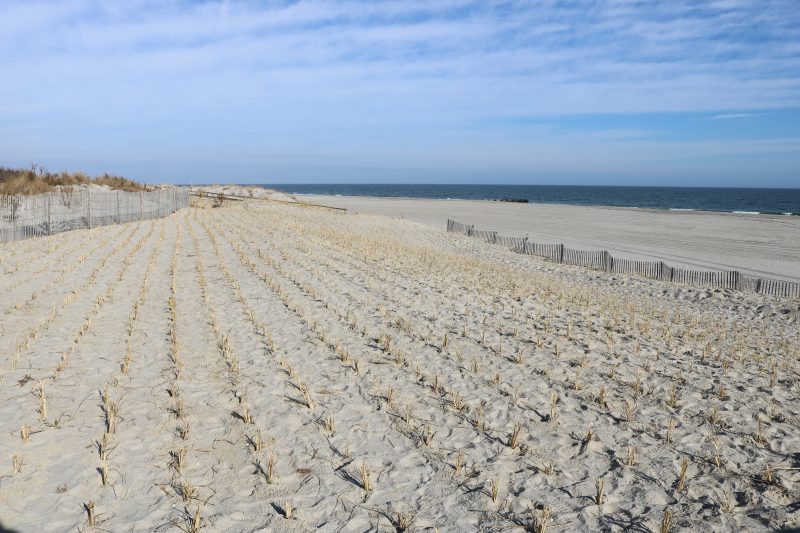Pools of water have accumulated on some spots on the beach, according to the New Jersey Department of Environmental Protection's report.
 By DONALD WITTKOWSKI
Sea Isle City’s beaches and dunes were replenished last summer with more than 750,000 cubic yards of fresh sand, enough to fill about 75,000 dump trucks.
Although much of the attention was paid to the aesthetics of having wider, more beautiful beaches, there was also a practical reason for the project – protection from the ocean’s wrath during coastal storms.
The value of having wide beaches and fortified dunes has been abundantly clear this month amid a succession of wicked nor’easters combining gusty winds, flooding, rain and even some snow.
The verdict? Sea Isle’s beaches and dunes remain in good shape despite being lashed by the nasty storm conditions, according to a newly released report by the New Jersey Department of Environmental Protection.
Mayor Leonard Desiderio was ecstatic that the beaches survived a powerful nor’easter that lingered for three days from Jan. 31 to Feb. 2.
“We were extremely happy we were able to do that,” Desiderio said in an interview. “Our first concern is the safety of our citizens. Next, is our beaches and dunes. We were very, very happy we fared well during this storm.”
Overall, the DEP report found only minor damage mainly consisting of some erosion along the beaches between 33rd and 57th streets.
“The beaches are in fine condition, with very, very minor damage. There was no property damage,” Desiderio said. “A lot of that has to do with the beach replenishment project last summer. It also shored up our dunes.”
By DONALD WITTKOWSKI
Sea Isle City’s beaches and dunes were replenished last summer with more than 750,000 cubic yards of fresh sand, enough to fill about 75,000 dump trucks.
Although much of the attention was paid to the aesthetics of having wider, more beautiful beaches, there was also a practical reason for the project – protection from the ocean’s wrath during coastal storms.
The value of having wide beaches and fortified dunes has been abundantly clear this month amid a succession of wicked nor’easters combining gusty winds, flooding, rain and even some snow.
The verdict? Sea Isle’s beaches and dunes remain in good shape despite being lashed by the nasty storm conditions, according to a newly released report by the New Jersey Department of Environmental Protection.
Mayor Leonard Desiderio was ecstatic that the beaches survived a powerful nor’easter that lingered for three days from Jan. 31 to Feb. 2.
“We were extremely happy we were able to do that,” Desiderio said in an interview. “Our first concern is the safety of our citizens. Next, is our beaches and dunes. We were very, very happy we fared well during this storm.”
Overall, the DEP report found only minor damage mainly consisting of some erosion along the beaches between 33rd and 57th streets.
“The beaches are in fine condition, with very, very minor damage. There was no property damage,” Desiderio said. “A lot of that has to do with the beach replenishment project last summer. It also shored up our dunes.”
 Pools of water have accumulated in some spots on the beach following the storms, according to the New Jersey Department of Environmental Protection's report.
The report also said there were some instances where the waves or high tide touched the upper beach. What were characterized as “small isolated pockets” of the dunes were sliced away up to 2 feet high.
According to the report, there was also some evidence of ponding – or pools of water – accumulating on the upper beach as well as some redistribution of the sand.
Although Sea Isle’s beaches escaped with only minor storm damage so far, other Jersey Shore towns are not so lucky.
The DEP report found that a number of coastal communities, particularly in Ocean County, were hammered with major damage during the three-day nor’easter. Now those towns are seeking the federal government’s help in rebuilding their beaches and dunes.
The timing of Sea Isle’s beach replenishment project was fortuitous. Under the direction of the U.S. Army Corps of Engineers, the project was broken into two parts.
Altogether, 510,000 cubic yards of new sand was deposited on the beaches from about 75th Street to 93rd Street in Townsends Inlet. Another 250,000 cubic yards of sand freshened up the beaches from 28th Street to 53rd Street in the center of town.
Most of the replenishment project involved widening the beaches. However, in some areas the dunes, beach access points and sand fencing were repaired.
Sand dunes form a natural barrier to protect shore towns from coastal storms, acting as a massive wall to block the raging surf from damaging or destroying homes and businesses.
To fortify the dunes, the Army Corps of Engineers planted dune grass and other vegetation in January as the last part of Sea Isle’s beach replenishment project.
Pools of water have accumulated in some spots on the beach following the storms, according to the New Jersey Department of Environmental Protection's report.
The report also said there were some instances where the waves or high tide touched the upper beach. What were characterized as “small isolated pockets” of the dunes were sliced away up to 2 feet high.
According to the report, there was also some evidence of ponding – or pools of water – accumulating on the upper beach as well as some redistribution of the sand.
Although Sea Isle’s beaches escaped with only minor storm damage so far, other Jersey Shore towns are not so lucky.
The DEP report found that a number of coastal communities, particularly in Ocean County, were hammered with major damage during the three-day nor’easter. Now those towns are seeking the federal government’s help in rebuilding their beaches and dunes.
The timing of Sea Isle’s beach replenishment project was fortuitous. Under the direction of the U.S. Army Corps of Engineers, the project was broken into two parts.
Altogether, 510,000 cubic yards of new sand was deposited on the beaches from about 75th Street to 93rd Street in Townsends Inlet. Another 250,000 cubic yards of sand freshened up the beaches from 28th Street to 53rd Street in the center of town.
Most of the replenishment project involved widening the beaches. However, in some areas the dunes, beach access points and sand fencing were repaired.
Sand dunes form a natural barrier to protect shore towns from coastal storms, acting as a massive wall to block the raging surf from damaging or destroying homes and businesses.
To fortify the dunes, the Army Corps of Engineers planted dune grass and other vegetation in January as the last part of Sea Isle’s beach replenishment project.
 Rows of dune grass planted in January will help to strengthen the dunes once they grow out in the spring.
Rows of dune grass planted in January will help to strengthen the dunes once they grow out in the spring.